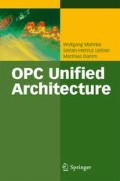Why Information Modeling?
The fundaments of OPC UA are data transport and information modeling. Compared to Classic OPC, the data transport was changed to state-of-the-art, platform-independent, secure, and reliable technologies and the capabilities to model information are highly improved. In Classic OPC, only “pure” data is provided, for example, the temperature measured by a temperature sensor. The only information available to understand the semantic of the provided data is the tag name and some rudimentary information like the engineering unit of the measured value. OPC UA provides more powerful possibilities exposing the semantic of the provided data. In addition to the data provided by Classic OPC, it allows exposing information like that the measured temperature is provided by a specific type of sensor device and allows to expose in a type hierarchy what kind of devices are supported. Thereby, OPC UA clients can get the information that they are dealing with the same kind of device at different places. By exposing much more semantics, OPC UA servers allow clients to process highly sophisticated tasks by interpreting the semantic of the provided data. That includes the automated integration of data provided by an OPC UA server as well as engineering an OPC UA server from a generic OPC UA client.
Access this chapter
Tax calculation will be finalised at checkout
Purchases are for personal use only
Notes
- 1.
Of course the base “References” ReferenceType does not have a supertype, since it is the root of the hierarchy.
- 2.
Another requirement to fulfill this constraint is that only HierarchicalReferences and NonHierarchicalReferences are allowed to directly inherit from References.
- 3.
However, it is not allowed that a Node references itself directly with a hierarchical Reference.
- 4.
Please be aware that the HasSubtype Reference is modeled pointing from the supertype to the subtype. It is a hierarchical Reference and therefore it makes sense to expose a type hierarchy in that direction. However, typically in modeling languages like UML the subtype points to its supertype.
- 5.
The WriteMask and UserWriteMask can be used as well; however, here something may need to be changed by some server-internal logic since Objects and ObjectTypes have different Attri?butes.
- 6.
Please be aware that the actual OPC DA Wrapper implementation of the OPC Foundation does not use a subtype but directly uses the FolderType for DA branches.
- 7.
Please note that all Objects and Variables used as InstanceDeclarations are typed, although the type is not exposed in most of the examples shown so far. All constraints valid for Objects and Variables used as instances are valid for Objects and Variables used as InstanceDeclarations as well.
- 8.
There is no clear responsibility defined who has to delete the Node. It could be either done automatically by the server or by a client. However, if a client requests to delete only Address3, the server either has to delete the Street Node as well or reject the request.
- 9.
Since there are different strategies how to deal with conflicts when using multiple inheritance, providing one specific semantic would exclude the simple mapping for models using a different semantic.
- 10.
By the way: Icon is an optional standard Property for Objects and ObjectTypes defined in [UA Part 3]
- 11.
In SQL [ISO08a] similar types are called distinct types.
- 12.
There is a standard Property called DataTypeVersion, indicating if the information has changed. While the Value of that Property has not changed, clients can use their cached version.
Author information
Authors and Affiliations
Corresponding author
Rights and permissions
Copyright information
© 2009 Springer-Verlag Berlin Heidelberg
About this chapter
Cite this chapter
Mahnke, W., Leitner, SH. (2009). Information Modeling: Concepts. In: OPC Unified Architecture. Springer, Berlin, Heidelberg. https://doi.org/10.1007/978-3-540-68899-0_2
Download citation
DOI: https://doi.org/10.1007/978-3-540-68899-0_2
Published:
Publisher Name: Springer, Berlin, Heidelberg
Print ISBN: 978-3-540-68898-3
Online ISBN: 978-3-540-68899-0
eBook Packages: Computer ScienceComputer Science (R0)

